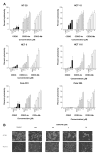Synthetic triterpenoids inhibit growth, induce apoptosis and suppress pro-survival Akt, mTOR and NF-{kappa}B signaling proteins in colorectal cancer cells
- PMID: 20392997
- PMCID: PMC3816511
Synthetic triterpenoids inhibit growth, induce apoptosis and suppress pro-survival Akt, mTOR and NF-{kappa}B signaling proteins in colorectal cancer cells
Abstract
Lack of apoptotic cell death has been implicated in malignant transformation and resistance to anticancer therapies. The promotion of apoptosis in cancer cells could potentially lead to the regression and improved prognosis of refractory colorectal cancer. Synthetic triterpenoids have shown strong antitumorigenic activity towards diverse cancer cell types, but have not been investigated for colorectal cancer. In the present study, we tested the apoptosis-inducing activity of oleanane triterpenoid 2-cyano-3,12-dioxooleana-1,9(11)-dien-28-oic acid (CDDO) and its C-28 methyl ester (CDDO-Me) and C-28 imidazole (CDDO-Im) derivatives in colorectal cancer cells lines. Cell growth/viability assay (MTS) demonstrated that colorectal cancer cells are highly sensitive to CDDO-Me at concentrations of 1.25 to 10 microM. The primary mode of tumor cell destruction was apoptosis as demonstrated by the cleavage of PARP-1, activation of procaspases -3, -8, and -9 and mitochondrial depolarization. Induction of apoptosis by CDDO-Me was associated with the inhibition of pro-survival Akt, NF-kappaB and mTOR signaling proteins and NF-kappaB-regulated anti-apoptotic Bcl-2, Bcl-xL, Bad and survivin. These studies provide rationale for clinical evaluation of CDDO-Me for the treatment of advanced chemotherapy refractory colorectal cancer.
Figures





Similar articles
-
CDDO-me induces apoptosis and inhibits Akt, mTOR and NF-kappaB signaling proteins in prostate cancer cells.Anticancer Res. 2007 Sep-Oct;27(5A):3035-44. Anticancer Res. 2007. PMID: 17970042
-
Synthetic triterpenoids inhibit growth and induce apoptosis in human glioblastoma and neuroblastoma cells through inhibition of prosurvival Akt, NF-kappaB and Notch1 signaling.J Neurooncol. 2007 Sep;84(2):147-57. doi: 10.1007/s11060-007-9364-9. Epub 2007 Mar 15. J Neurooncol. 2007. PMID: 17361329
-
Oleanane triterpenoid CDDO-Me inhibits growth and induces apoptosis in prostate cancer cells by independently targeting pro-survival Akt and mTOR.Prostate. 2009 Jun 1;69(8):851-60. doi: 10.1002/pros.20937. Prostate. 2009. PMID: 19189297 Free PMC article.
-
Synthesis and Anticancer Activity of CDDO and CDDO-Me, Two Derivatives of Natural Triterpenoids.Molecules. 2019 Nov 13;24(22):4097. doi: 10.3390/molecules24224097. Molecules. 2019. PMID: 31766211 Free PMC article. Review.
-
Triterpenoids as new promising anticancer drugs.Anticancer Drugs. 2009 Nov;20(10):880-92. doi: 10.1097/CAD.0b013e328330fd90. Anticancer Drugs. 2009. PMID: 19745720 Review.
Cited by
-
The synthetic triterpenoid CDDO-Imidazolide suppresses experimental liver metastasis.Clin Exp Metastasis. 2011 Mar;28(3):309-17. doi: 10.1007/s10585-011-9374-z. Epub 2011 Jan 15. Clin Exp Metastasis. 2011. PMID: 21234655
-
The role of natural products in revealing NRF2 function.Nat Prod Rep. 2020 Jun 1;37(6):797-826. doi: 10.1039/c9np00061e. Epub 2020 May 13. Nat Prod Rep. 2020. PMID: 32400766 Free PMC article. Review.
-
Synthesis of Cyanoenone-Modified Diterpenoid Analogs as Novel Bmi-1-Mediated Antitumor Agents.ACS Med Chem Lett. 2018 Sep 27;9(11):1105-1110. doi: 10.1021/acsmedchemlett.8b00345. eCollection 2018 Nov 8. ACS Med Chem Lett. 2018. PMID: 30429953 Free PMC article.
-
Targeting nrf2-mediated gene transcription by triterpenoids and their derivatives.Biomol Ther (Seoul). 2012 Nov;20(6):499-505. doi: 10.4062/biomolther.2012.20.6.499. Biomol Ther (Seoul). 2012. PMID: 24009841 Free PMC article. Review.
-
The triterpenoid CDDO-Me promotes hematopoietic progenitor expansion and myelopoiesis in mice.Biol Blood Marrow Transplant. 2012 Mar;18(3):396-405. doi: 10.1016/j.bbmt.2011.11.013. Epub 2011 Nov 17. Biol Blood Marrow Transplant. 2012. PMID: 22100978 Free PMC article.
References
-
- Giovannucci E, Willett WC. Dietary factors and risk of colon cancer. Ann Med. 1994;26:443–452. - PubMed
-
- Rao CV, Hirose Y, Indranie C, Reddy BS. Modulation of experimental colon tumorigenesis by types and amounts of dietary fatty acids. Cancer Res. 2001;61:1927–1933. - PubMed
-
- Moser AR, Pitot HC, Dove WF. A dominant mutation that predisposes to multiple intestinal neoplasia in the mouse. Science. 1990;247:322–324. - PubMed
-
- Kinzler KW, Vogelstein B. Cancer-susceptibility genes: gatekeepers and caretakers. Nature. 1997;386:761–763. - PubMed
-
- Su LK, Kinzler KW, Vogelstein B, Preisinger AC, Moser AR, Luongo C, Gould KA, Dove WF. Multiple intestinal neoplasia caused by a mutation in the murine homolog of the APC gene. Science. 1992;256:668–670. - PubMed
Publication types
MeSH terms
Substances
Grants and funding
LinkOut - more resources
Full Text Sources
Other Literature Sources
Medical
Research Materials
Miscellaneous
